There are quite a few different kinds of demons that appear throughout Dragon Ball. It can be hard to keep them all separate, especially because the terms used for them vary between translations. This mini-guide will explain what the different types are, what their Japanese name means, what role they play in Dragon Ball, and any other tidbits that seem worth mentioning.
Demon Clan (魔族 / mazoku)
Probably the most important and most confusing of the demons we see in Dragon Ball are the mazoku. This section will be split up between the terms as it is used in the manga and the anime. The second kanji character zoku means “tribe”, while the first character is ma, which in Japanese denotes something as both demonic and magical, and which as you might expect will be popping up quite a lot in this guide.
Manga
In the manga, the only members of the Demon Clan we are introduced to are Piccolo Daimaō and his offspring, Cymbal, Tambourine, Drum, Piano, and eventually Ma Junior. Their special characteristic is that the spirits of those killed by them are unable to pass on into the afterlife, and instead remain in the living world, suffering (fans sometimes mistakenly say those killed by them go to limbo). Similarly, their ki is able to permanently destroy a Kinto-Un, something normal weapons cannot do. It is never really stated what qualifies one as a member of the Demon Clan, but since Piccolo Daimaō was born from the evil in God’s heart, it seems that being pure evil or at least close to it is the major factor. This is supported by the fact that Ma Junior no longer has the characteristics of the Demon Clan by the time the battle with Raditz rolls around (Goku and Raditz’s souls both go to the afterlife) and that this is tied with Piccolo becoming less evil.
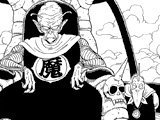
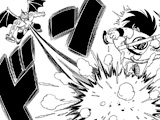
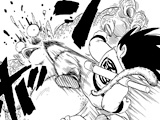
While Daimaō and Ma Junior look just like regular Namekians, Daimaō’s minions all look very different (though they are still all green at least), despite Daimaō giving birth to them in the usual Namekian way of spitting eggs from his mouth. Daimaō shows that he can control what the offspring will look like before birthing it (he says that he will make Cymbal dragon-like since it will be his job to hunt down the Dragon Balls), so this is most likely the reason for all his offspring’s unusual appearances. However, it is not known if this is something regular Namekians can do but never choose to, or if Daimaō only has this power due to his demonic nature.

Some fans have been a tad confused, thinking that Piccolo (Ma Junior) never really was a demon, and that it was just him and the people of Earth misunderstanding his Namekian nature. The problem with this is that nobody ever thought God was a demon. God himself and everyone else thought he was just an unusual-looking Earthling and a talented martial artist. It is only God’s evil twin that was viewed as demonic. As noted above, Daimaō and company have unusual properties that regular Namekians do not possess.
Anime
In the anime, Garlic Jr.’s tribe is also referred to as the Demon Clan. They come from Planet Makyo (incorrectly called “Makyo Star” in FUNimation’s English dub; in the original it is an inhabited planet), a planet which draws near the Earth every 5,000 years. They are also sometimes referred to as makyō-seijin, or “people of Planet Makyo”. Garlic Jr.’s ancestors immigrated to Earth the last time Planet Makyo approached and have been causing trouble ever since. When Planet Makyo again draws near Earth in the Garlic Jr. arc, it increases the power of Garlic Jr. and co. many times over (which makes you wonder why they would leave the planet in the first place).
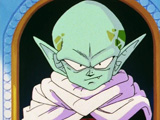
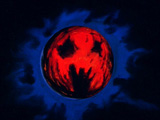
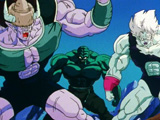
Three hundred years before the events of the series, Garlic (Garlic Jr.’s father) tried to become the Kami of Earth, but the then current Kami saw that he had bad intentions and rejected him. Garlic then mounted a rebellion against Kami, but was defeated and sealed away, leaving his son Garlic Jr. to eventually try to avenge him. Garlic Jr. possesses the Aqua Mist, which when inhaled awakens the evil within humans’ hearts, turning them into members of the Demon Clan. The idea that awakening the evil inside someone turns them into a Demon Clansman is actually pretty consistent with the Demon Clan in the manga. These Demon Clan humans can turn others into Demon Clansmen by biting them, similar to vampires. Other than that, the transformation does not seem to give them any special powers.
A third Demon Clan does make a brief appearance in Dragon Ball Z Movie 4: Slug and his henchmen. It is not said just where they are from, but it is possible they are from Planet Slug. At any rate, their greatest downfall is sensitivity to sunlight.
Majin 1 (魔人 / demon-human)
The main “Majin” example in the series is of course Majin Boo. Boo is a being created by the mage Bibbidi and is one of a kind as far as we know. Boo is pink, can regenerate as long as even a single one of his cell remains, can absorb others to take on their powers and physical characteristics… and can do lots of other things. In the computer game Dragon Ball Online, Boo takes a lover at some point after the events of the series, and by Age 1000 there is an entire race of majin descended from him.
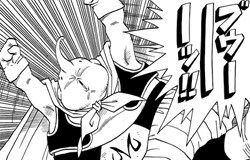

In the original series, Boo is the only one of Bobbidi’s minions ever referred to as majin. However, fans have long referred to those Bobbidi controls with his magic as majin as well, most prominently with “Majin Vegeta”. The name “Majin Vegeta” has now been used in video games and on FUNimation’s DVD releases, giving it a somewhat official status. There is also one thing in the original series that supports this naming scheme: Kaiōshin refers to Yakon as the “majuu Yakon”, literally calling him the “demon-beast Yakon”. Majuu (魔獣) is essentially the animal equivalent of majin. However, it is possible that Yakon was known as this even before he fell under Bobbidi’s spell. Whether or not those manipulated by Bobbidi’s magic can also be called majin, they are clearly a different sort of being than Boo. They are all originally powerful warriors with evil hearts from throughout the universe, who Bobbidi brainwashed by manipulating their evil hearts with his magic. Their power is brought-out by Bobbidi beyond their own limits, giving them bulging veins and somewhat zombie-like powers (being able to survive having their neck broken, for instance). Those warriors controlled by Bobbidi have an “M”-mark appear on their forehead (or in Yakon’s case, his stomach). It is not known just what this “M” stands for. “Majin” is one possibility, but it could also stand for “madōshi” (Bobbidi’s title, meaning “mage” or “warlock”). It could also simply be an alien symbol that only coincidentally resembles the letter M, similar to how Superman’s S is supposed to be a Kryptonian symbol.
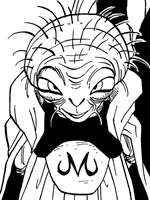
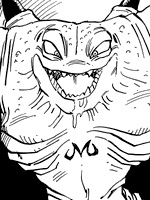
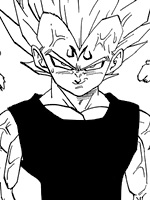
There may be other majin in the Dragon Ball universe, as Goten and Trunks seemed to both recognized the word “majin” when they first heard it and even Gohan says that since Boo is called a majin he expected he would be much bigger. However, it is possible that their knowledge is based entirely on mere stories (they obviously have not actually met any majin before), or even legends ultimately based on Boo himself.
A much lesser known majin is “Majin Ozotto”, the final enemy in the Dragon Ball Z V.R.V.S. arcade game, whose name is rather bizarrely given in English as “Ozotto the Super Monster”. Ozotto has the ability to transform into the other fighters in the game, similar to Shang Tsung in the Mortal Kombat series. In his normal form he has three eyes and looks like a cross between second-form Freeza, Janenba, and Hildegarn.
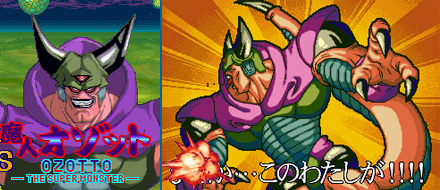
While it can be used for a variety of different mythological and fictional magical beings, the term majin is very often used in Japanese for genie (djinn in Arabic). The term is generally used in translations of the story of Aladdin; in fact the Disney character Genie is called “Majin Genie” in Japanese. This is why Viz translates “majin” as “djinn”, although this caused quite a bit of confusion among English-speaking fans at the time.
Majin 2 (魔神 / demon-god)
While the term “majin” as discussed above was written with the kanji for “demon-man”, this term is written with the kanji for “demon-god”, but read the same way (the “Majin” in Majin Boo’s name is sometimes incorrectly written like this). In Dragon Ball, it is used for Lucifer and his followers from Dragon Ball Movie 2, Sleeping Princess in Devil’s Castle; the “devil” in the title is actually “majin” in the Japanese title. They live in the titular Majin Castle and hate sunlight, which is why they attempt to destroy the sun.
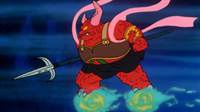
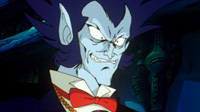
Phantom Majin (幻魔人 / gen-majin)
“Gen-majin” is the term used for Hildegarn from Dragon Ball Z movie 13. It is made by appending the kanji for “phantom” to the two kanji for “majin”. Steve Simmon’s subtitles on the FUNimation releases translate the term as “phantasm”. Hildegarn was originally a statue on Planet Conuts, but a clan of evil wizards infused it with evil, turning into a living monster. It evades attacks by turning into smoke, and using its tail to absorb the energy of living beings, similar to Cell. It is cut in half and sealed with Tapion and Minoshia, which leads into Dragon Ball Z movie 13. “Gen-majin” is something of a rare term in Japanese; there is not much information out there on it. “Genma” (幻魔), however, is the name of an evil, demonic race in the manga series Genma Taisen (Genma Wars, aka Harmagedon), as well as the video game series Onimusha.
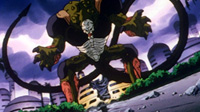
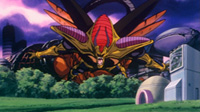
Devils (悪魔 / akuma)
Combining the kanji for “evil” and “demon” gets you “devils” (or alternatively, per Jim Breen’s online Japanese dictionary, “demon; fiend; Satan; evil spirit”). If you are a One Piece fan, you probably know that the Japanese name for the Devil Fruit is akuma no mi. There is also a Street Fighter character named “Akuma” (whose original Japanese name is actually Gouki). In Dragon Ball, devils are a race indigenous to Hell and the only one we see is the aptly-name Akkuman, the strongest of Uranai Baba’s fighters before Grandpa Gohan appears.
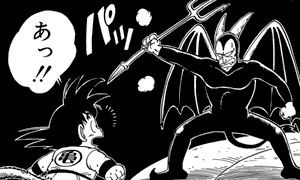
Akkuman (sometimes known as “Devilman” in English translations, but not to be confused with the Go Nagai character) looks very similar to standard depictions of Satan and even fights with a pitchfork. The fact that Akkuman is a devil from Hell is established in the manga where he threatens to carry Goku to his homeland, Hell. However, Daizenshuu 7 slightly expands on this by noting that “devil” is not a general term for Hell’s life-forms, but just designates Akkuman’s specific hellish race. Interestingly, the Adventure Special databook says that Akkuman has an older sister named Majon (a pun on majo, meaning “witch”).
At any rate, the Hell that Akkuman and his race of devils come from is the place located directly beneath Serpent Road, where the souls of the wicked dead are punished, and is not to be confused with Dabra’s Demon Realm. However, according to Enma-daiō, the two are similar, to the point where Dabra would be happy in Hell. To make things really confusing, Dabra’s Demon Realm (makai) is sometimes referred to as the Devil Realm (akumakai)… and yet, they are different places. Are you confused yet?
Interestingly, “Akkuman” is also the name of the protagonist of another series by Toriyama, Go! Go! Ackman (this is an alternative transliteration of “Akkuman”). However, these two characters do not look anything alike; this Akkuman looks like a short, red version of future Trunks. This Akkuman is also a devil, who kills humans to collect their souls and give them to the great demon king in exchange for valuable prizes.
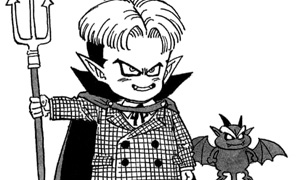
Years later, after having the name duplication brought to his attention, Toriyama stated in the 2004 guide book Dragon Ball FOREVER:
Since he’s demonic I named him Akkuman, but I carelessly forgot and made a manga that was also named AkkuMan. I guess it’s a pretty simple idea.
The character Chivil from Dr. Slump is also similar to Akkuman, resembling a baby version of him. He is also a devil, and comes out from Hell through a volcano to constantly attempt to kill the other characters. He ultimately cannot though, because Dr. Slump is a gag manga, and characters always come back to life no matter what (this is something Freeza also found out the hard way in the Dragon Ball/Kochi-Kame crossover).
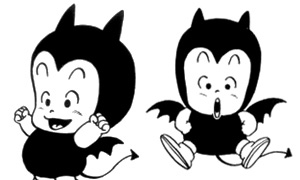
Oni (鬼)
Oni are beings from Japanese mythology who are something of a mix between a demon and a troll or ogre. They generally have horns, come in red or blue, wear tiger-skins, and carry large spiked clubs. During his first appearance, Oolong terrifies the villagers by transforming into this sort of Oni. In Buddhist mythology, Enma-daiō is assisted by Oni, which is also the main role they appear in throughout Dragon Ball. In Dragon Ball, Enma-daiō‘s Oni servants appear dressed as business men. They still have the blue and red skin and the horns though, plus tiger-skin ties and pants.
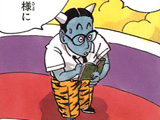

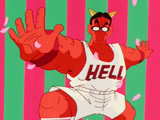
Interestingly, all of the Oni characters constantly insert “oni” into their sentences in the anime. Also in the anime, we get to see the Oni Gozu and Mezu, who guard Hell. Unlike the Oni who work at Enma’s castle, they both wear a sort of gym outfit. The two are named for the cow-head (牛頭/gozu) and horse-head (馬頭/mezu) Oni who are featured in depictions of Buddhist Hell. While the pair appears in Hell, they simply work there, as opposed to the devils that live there and the wicked souls imprisoned there. Another important Oni from the anime is the Psyche-Oni, also known as the “tank boy”, who gets transfigured into Janenba in Dragon Ball Z Movie 12. His name is short for “Psychedelic Oni“, after his musical tastes, and is often mis-transliterated into English as “Saike-Oni“.
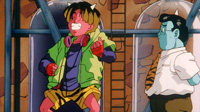
Demon Realm (魔界 / makai)
Also known as the “Demon Realm of Darkness” (暗黒魔界/ankoku-makai) and the “Devil Realm” (悪魔界/akumakai), and all three of these names are used in the manga itself! Quite a jumble of nomenclature for something we (probably) never even see. At any rate, this is the place Dabra comes from, and is king of. It is a dimension separate from the universe which Goku and co. live in, located on the opposite side of their dimension, like the bottom side of a coin (more specifically, Daizenshuu 7 and the Super Exciting Guide books show it as being in the little pointy tip at the bottom of the snow globe that is the cosmos). While Goku and company are the strongest beings in their universe, in the Demon Realm Dabra is far and away the strongest person around.
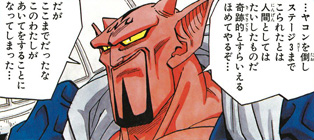
It is very similar to Hell, to the point where Enma thought Dabra would be happy to go there, so he sent him to Heaven instead (this is mentioned in the manga, but we only actually see Dabra in Heaven in the anime). However, Hell is in the afterlife, while the Demon Realm is part of the living world. Other than that there is not a whole lot of information about the place in the series itself. Daizenshuu 7 gives a little bit more, saying that it is home to evil life-forms who have sometimes disrupted the peace of the universe, and that the gods do not watch over it. It also says that like the universe itself, it is divided up into various parts, but Dabra rules over them all (or did; it is unclear what his status is now that he is serving Bobbidi). As already mentioned, we never explicitly see the Demon Realm firsthand in the series, though Bobbidi transports Gohan and Dabra to a rocky landscape during the course of their fight. Since Bobbidi transported Pui Pui and Yakon to their respective home worlds to try and give them an edge in their fights with Goku and company, it is possible that the place Gohan and Dabra fight is part of the Demon Realm, but this is just pure speculation.
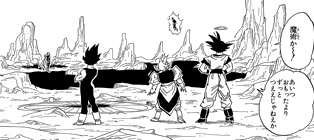
According to Toriyama in the 2009 Super Exciting Guide: Character Volume, the Demon Realm is home to the Makaiō (魔界王; “Demon Realm Kings”) and Makaiōshin (魔界王神; “Gods of the Demon Realm Kings”), who rule over evil and are the antitheses of the Kaiō and Kaiōshin. Toriyama does not really say where Makaiō and Makaiōshin come from, only that delinquent members of the Shin-jin (literally “Core People”; the Kaiō and Kaiōshin are members of this race) go to be with the Makaiō and Makaiōshin. It is not clear whether these evil Shin-jin ultimately become Makaiō and Makaiōshin themselves, or if they simply serve as their allies. It is not known how many Makaiō and Makaiōshin there are, though if they are like their good counterparts, there should be five of each. Importantly, it is also unclear whether or not Dabra himself is a Makaiō or Makaiōshin. He is called the king of the Demon Realm (魔界の王/makai no ō), which is what “Makaiō” means, but the terms “Makaiō” and “Makaiōshin” are never used in the series. Also, Toriyama says that currently, the Makaiōshin are weaker than the Kaiōshin, but East Kaiōshin was terrified of Dabra’s strength. It is possible that Dabra is simply a “regular” inhabitant of the Demon Realm who happens to have surpassed the gods who are supposed to be supreme there, similar to how Goku himself eventually surpassed the various regular gods, including Kaiōshin.
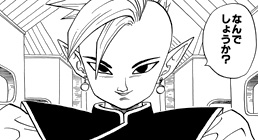
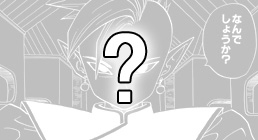
There is no real name for Dabra and the other inhabitants of the Demon Realm. Daizenshuu 7’s character dictionary simply lists Dabra and Shura (see below) as being of the “Demon Realm race” (魔界の種族/makai no shuzoku).
In the anime, there is a filler episode where Goku is training for the 22nd Tenka’ichi Budōkai, and he visits a village located near the Demon Realm Gate, which just like it sounds like is a portal to the Demon Realm. Evil beings from the Demon Realm come out of this gate and torment the village, and most recently Shura, the martial arts master of the Demon Realm, has kidnapped Princess Mise, so Goku goes to the Demon Realm and rescues her.
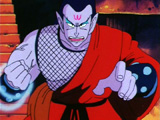
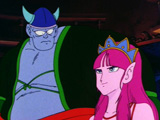
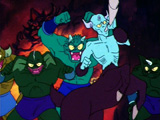
Now, this all happened long before Dabra appeared in either the manga or anime. We know Toriyama did submit filler ideas to the anime (such as Gregory or Yamcha’s job playing baseball), so it is possible he gave the general idea for this episode, then reused it much later. It is also possible that he had nothing to do with the episode, but saw it and eventually decided to use the “Demon Realm” idea (Toriyama did watch the anime weekly, usually with his kids). However, “Demon Realm (makai)” is such a common and generic term in manga, anime, and video games that it is most likely Toriyama simply came up with it for Dabra’s back-story completely independent of the earlier use of the term. Still, looking at the series as a whole, it is tempting to link Shura and Dabra’s Demon Realm together as one and the same, especially since we have so little information on Dabra’s.
Mamono (魔物)
Literally meaning “magical/demonic things” (we like to translate it as “fiends”), this is a generic term for magical and/or demonic beings that appear in many anime, manga, and video games. The various monsters in the Castlevania games are called this, as are the demonic beings in Gash Bell (in the English version of Gash Bell, mamono is very bizarrely changed to “mamodo”). Some of the other more specific types of demons are called this sometimes (like with Lucifer’s followers or Shura’s underlings) and the movie villains guide in Daizenshuu 6 uses this as a general term that encompasses more specific types of demons like Garlic Jr.’s Demon Clan and the phantom-majin Hildegarn, just as they use “alien” as a general term encompassing things like Saiyans, Namekians, and various nameless races.
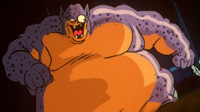
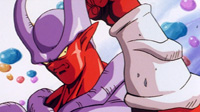
Yōkai (妖怪)
The word “yōkai” refers to all sorts of different spooks and specters found throughout Japanese mythology, and is variously translated as “goblin”, “demon”, “phantom”, “monster”, or other terms, depending on the context. As you might guess, “yōkai” is a rather broad concept, and it is difficult to generalize about them, but they are essentially supernatural beings with powers and motives beyond human understanding. They come in all shapes and sizes, but commonly have the ability to shape-shift into other forms in order to trick or terrify humans. Because of this, in Dragon Ball Oolong is referred to as a yōkai when he first appears, due to his shape-shifting abilities. However, in reality Oolong is simply an otherwise ordinary Animal-Type Earthling who happened to have studied at the Southern Shape-Shifting Kindergarten. While there are not any examples of true yōkai in Dragon Ball, Toriyama’s prototype version of Dragon Ball, Dragon Boy, contains a shape-shifting yōkai who bears a striking resemblance to Pu’er. Outside of Dragon Ball, yōkai feature heavily in the manga/anime series GeGeGe no Kitarō, Yu Yu Hakusho, and Yōkai Ningen Bem. The Obakemono Project website features profiles on various yōkai from Japanese folklore.
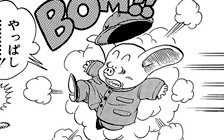
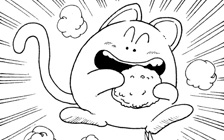
Neko Majin (ネコマジン)
While these guys do not actually appear in Dragon Ball proper, they have a whole Dragon Ball-parody manga devoted to them, so we figured we would include them here. A “Neko Majin” is essentially a majin cat (see above for what a majin is). However, their name is written out in katakana and not kanji (where it would be written as 猫魔人), so it seems emphasis is being placed on the sounds of the words rather than their meaning. This is most likely why when Viz translated the last chapter of Neko Majin (the only one they have translated so far) they left the name as-is and did not translate neko to “cat” or majin to “djinn” like they did with Majin Boo… not to mention that the Japanese Neko Majin kanzenban has the title written out “Neko Majin” in a large, friendly, English-form.
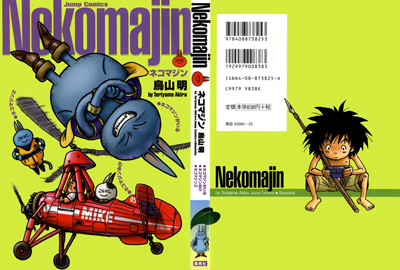
In the series, the Neko Majin are a race of cat-like magical beings who live throughout the world. There are about 100 of them total, and they come in different breeds, just like cats. The Neko Majin who appears in the first two stories, Neko Majin ga Iru 1 and 2, is actually Neko Majin Mix (as in mixed breed), while the protagonist of Neko Majin Mike is a calico cat (三毛/mike in Japanese; pronounced “mee-kay”). They have magical powers and can all fight very well, but the strongest is Neko Majin Z, who trained under Son Goku. Z has the unique and somewhat nonsensical ability to transform into a Super Neko Majin, and can fire the deadly Nekohameha. Neko Majin get their power from their Neko Majin ball, which they keep inside their bodies and can spit out of their mouth at will (generally only when forced to do so, as removing it from their body causes them to lose their powers). Neko Majin are extremely long-lived, possibly immortal, and can even sleep for 30-straight years. In addition to the Neko Majin, there is also at least one Usagi Majin (majin bunny), who is the enemy of the Neko Majin.
Mister Satan (ミスターサタン)
Although he is not actually demonic, his name most certainly is. According to Toriyama in the Dragon Ball LANDMARK guide book, “Since he’s a professional grappler, I used a name that would make him sound like one. Because this is his ring name, I think his actual name is probably something different”. In the Super Exciting Guide: Character Volume, Toriyama finally revealed that Mister Satan’s true name is Mark, a pun on akuma, or devil (if akuma is rearranged and rewritten, you get マーク/māku, the Japanese way of writing “Mark”).

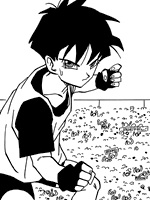
His daughter Videl’s name of course comes from rearranging the word “devil”. Mister Satan is often simply called “Satan” throughout the series, leading to such immortal moments as Goku saying “Well done Satan! You may be the Earth’s true savior!” and the entire world repeatedly shouting “Satan!” in unison (accompanied by happy, happy music in the anime). Good times.
